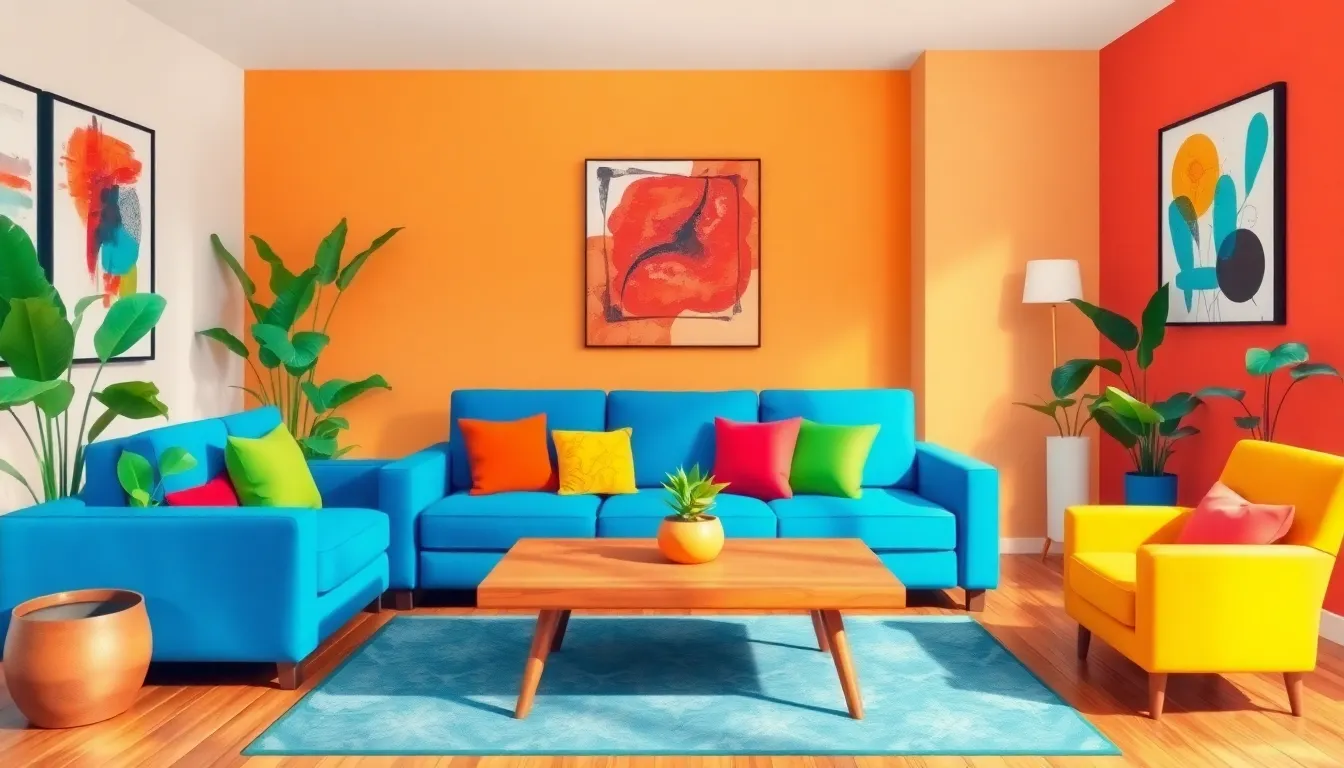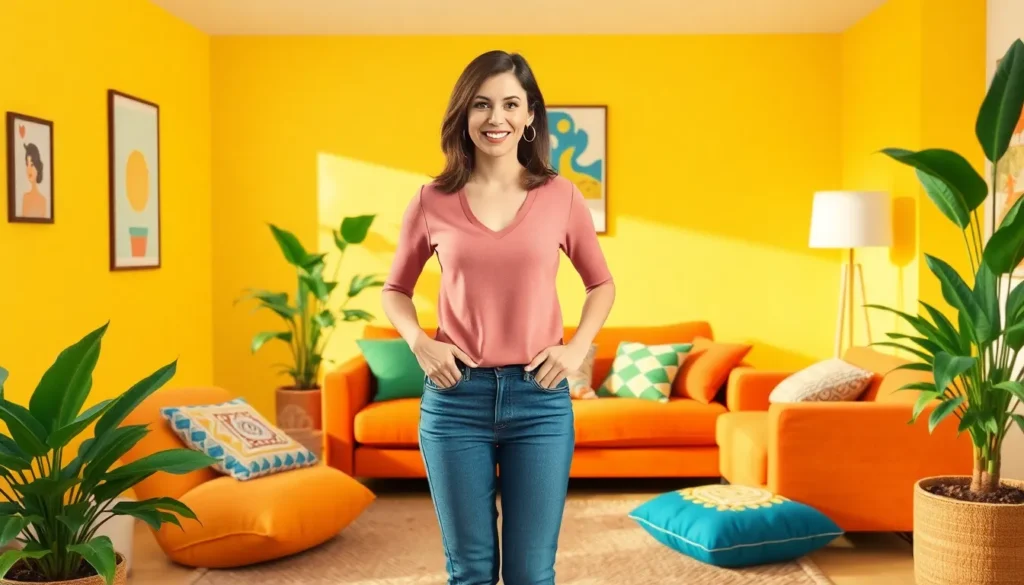Table of Contents
ToggleImagine walking into a room that feels like a party for your senses. Colorful concepts in interior design do just that, turning mundane spaces into vibrant havens. Who needs a boring beige wall when you can have a cheerful turquoise accent that practically sings? With the right splash of color, a room can transform from drab to fab faster than you can say “where’s my paintbrush?”
Color isn’t just for kids’ crayon boxes; it’s a powerful tool that can evoke emotions and set the mood. Whether it’s a bold red that ignites passion or a calming green that whispers tranquility, color choices shape our experiences in a space. So why settle for ordinary when extraordinary is just a brushstroke away? Dive into the world of colorful concepts and discover how to unleash your inner designer while keeping your guests guessing what your secret is.
Overview of Colorful Concepts Interior Design
Colorful concepts in interior design emphasize the use of vibrant hues to create dynamic environments. Designers often utilize bright shades to transform spaces, turning ordinary rooms into visually stunning areas. Various colors evoke specific feelings, influencing mood and atmosphere. For instance, warm tones like red and orange can inspire energy and excitement, while cool colors such as blue and green promote tranquility and calmness.
In colorful interior design, bold choices play a critical role. Chic accent walls often incorporate striking colors that draw attention and serve as focal points. Accessories, such as cushions and artwork, frequently showcase vibrant patterns, adding layers of visual interest. Lighting fixtures in bold colors also contribute dramatically to space transformation, enhancing the overall aesthetic.
Creative layering of colors creates depth and prevents monotony. Designers encourage the combination of contrasting colors to enrich visual appeal, producing striking effects. For example, pairing deep navy with bright yellow can result in a contemporary and lively atmosphere.
Furthermore, balance is essential in colorful concepts. A dominant color may anchor the space, supported by complementary accents that provide harmony. Natural elements, like plants, often introduce additional colors while softening the overall look.
Sustainability increasingly intertwines with colorful concepts. Many designers opt for eco-friendly materials dyed with vibrant pigments, aligning with modern ethical considerations. Sustainable practices in color sourcing not only enhance beauty but contribute to environmental responsibility. This commitment to sustainability in colorful designs reflects the evolving nature of interior spaces, making them not just visually appealing but also more conscious of their impact.
Key Principles of Colorful Concepts

Color plays a vital role in creating engaging interior environments. Understanding key principles helps reinforce the effectiveness of colorful design.
Balance and Harmony
Achieving balance ensures a cohesive look. Dominant colors require supporting accents for visual appeal. Warm shades can energize spaces while cool tones provide serenity. Designers often employ the 60-30-10 rule: 60% of a dominant color, 30% of a secondary shade, and 10% for accents. This arrangement creates harmony while avoiding overwhelming effects. Each color selection contributes to overall satisfaction and comfort. Thoughtful placement of colors results in a unified atmosphere that resonates with inhabitants.
Color Theory Basics
Familiarity with color theory enhances cohesive design. Primary colors—red, blue, and yellow—serve as the foundation. Secondary colors, produced by mixing primary colors, expand options, inviting creativity. Color wheel applications guide choices, encouraging harmonious combinations. Complementary color pairs, opposite on the wheel, offer visual contrasts. Analogous colors, adjacent on the wheel, create serene blends. Awareness of warm and cool tones enriches the emotional atmosphere. Designers can then connect colors to evoke specific moods or feelings. Understanding these fundamentals leads to powerful design decisions that elevate interiors.
Popular Color Palettes
Color choice significantly impacts the mood of interior spaces. Designers often gravitate towards specific palettes to create desired atmospheres.
Warm Colors
Warm colors like red, orange, and yellow radiate energy and vibrancy. These shades often evoke feelings of happiness and excitement in a room. Use warm colors on accent walls or furniture to create focal points. Kitchens and living areas benefit from these hues, as they encourage social interactions. Mixing warm tones with neutrals can balance intensity while maintaining warmth. Incorporating textiles like throws and cushions in warm colors enhances coziness.
Cool Colors
Cool colors such as blue, green, and purple instill calm and tranquility in interior spaces. These hues are excellent choices for bedrooms and bathrooms, promoting relaxation. Incorporate soft blues and greens to create a serene atmosphere. Pairing cool colors with natural materials enhances a fresh and airy feel. Cool shades work well for large spaces, making them feel open and inviting. Adding accents from the warm spectrum can bring a dynamic contrast and visual interest.
Implementing Colorful Concepts
Implementing colorful concepts enhances interior spaces by integrating vibrant elements. Designers often start with accent walls as focal points that transform a room’s ambiance. Accent walls allow for bold expressions through color, patterns, and textures. Selecting one wall to paint in a bright hue instantly draws attention, creating visual interest. Incorporating wallpaper with lively designs can add depth and personality without overwhelming the entire space.
Statement furniture also plays a crucial role in colorful interior design. Pieces like bright sofas or unique chairs serve as stunning focal points within any room. Choosing furniture in bold colors complements the overall palette and enhances the design narrative. Mixing textures, such as velvet and leather, can create layers and intrigue. Investing in statement furniture encourages creativity and personal flair, allowing the owner to showcase their individuality through design.
Colorful Concepts in Different Spaces
Colorful concepts enhance various spaces, creating unique atmospheres. In each room, specific colors evoke distinct emotions, contributing to overall design impact.
Living Rooms
Living rooms benefit from vibrant color choices that encourage social interaction. Warm tones, like orange and yellow, infuse energy, promoting conversation and activity. A bold accent wall can serve as a focal point, making the space feel inviting. Bright accessories, such as cushions and art pieces, add depth and visual interest without overwhelming the design. Combining neutrals with vibrant colors creates a balanced aesthetic, allowing warmth to shine while maintaining harmony. Statement furniture, like a vivid sofa or eclectic chairs, enhances the overall appeal, drawing attention and stimulating creativity in the space.
Bedrooms
Bedrooms require calming colors to promote relaxation and rest. Soft blues and greens cultivate tranquility, ideal for creating a peaceful retreat. A feature wall in a gentle hue can set the tone, making the room feel cozy. Incorporating textiles in warm or bold prints adds comfort and character. Combining colors with warm accents, such as golden or coral accessories, introduces a dynamic flair without sacrificing calmness. Thoughtful arrangements of color maintain balance while enhancing the overall soothing environment, ensuring a restful sleep experience.
Colorful concepts in interior design offer a vibrant pathway to transform spaces and evoke emotions. By embracing bold hues and thoughtful combinations, individuals can create environments that reflect their personality and enhance their daily lives. The balance of colors not only adds visual interest but also fosters harmony within a room.
As designers continue to innovate with sustainable materials and creative palettes, the possibilities for colorful interiors expand. Whether through accent walls or statement furniture, every choice contributes to a unique atmosphere tailored to individual needs. Ultimately, the power of color lies in its ability to inspire and uplift, making every space a true reflection of its inhabitants.




